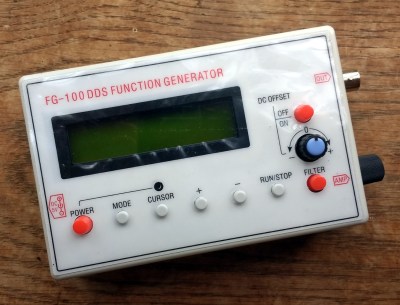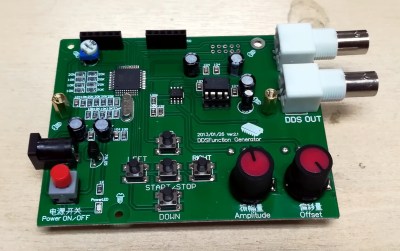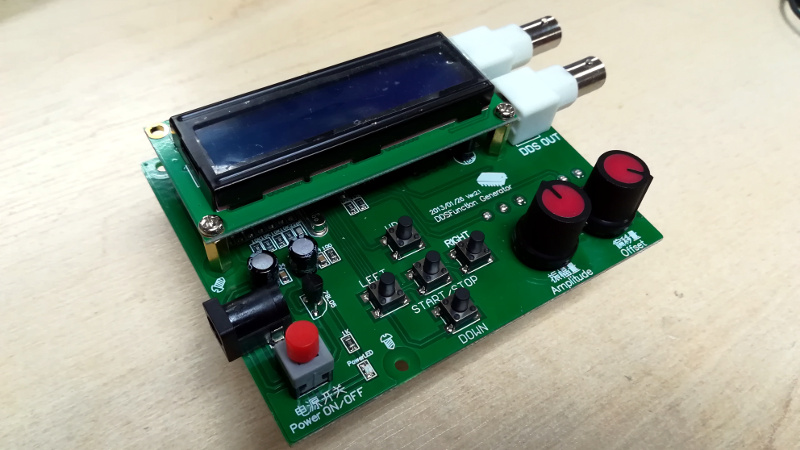
A lifetime of amassing random pieces of test equipment has left me with a gap in my armoury, namely that I don’t possess a low frequency function generator. This could easily be addressed, but for two things. I have a love for exploring the cheaper end of exported electronics and my need for a function generator is less than my desire to spend significant cash. I’ve tried to balance these competing forces in the past by picking up an astoundingly cheap instrument; that time I ended up with a lemon, but will lightning strike twice in the same spot? I spent £10 ($13) on a different cheap function generator and set off to find out.
So Good, They Forgot To Name It
I could tell my DDS function generator was a quality product when I opened the anti-static bag it came in, for whoever manufactured it wasn’t prepared to put their name to it and it has no model number I can see. Hence I’ll refer to it as the Unnamed Chinese DDS Function Generator. Jokes aside, it seems to be of a generic type that can be found from a variety of the usual online stockists. It takes the form of a PCB about 100 mm by 80 mm with one of the ubiquitous alphanumeric display modules atop it, and a couple of BNC sockets for output. Control is via a set of momentary action buttons, and there are a couple of potentiometers for level and DC offset. Finally there is a 2.1 mm barrel jack through which it will accept 7 V to 9 V DC. Surprisingly the polarity of this is unlabelled, but a quick check of the electrolytic capacitor it’s connected to revealed the centre pin to be positive.
The previous cheap function generator had been an ATmega328 with a resistor ladder DAC, and it suffered from both huge distortion and inconsistent amplitude over its frequency range. I’m not expecting this one to be on a par with a four-figure-sum signal generator, but as long as it can deliver the waveform it claims and at the same amplitude and offset across its range then I’ll be happy with it. So my first order of business was to hook up the ‘scope and see how it handles delivering a sine wave.

The good news is that this generator does exactly what it claims. From its 1 Hz lower end to its 65.5 kHz upper end, the sine wave shape remains the same and the amplitude and offset I selected on the two potentiometers is consistent. The other waveforms are the same, square, triangle, sawtooth, random noise, and unexpectedly, an ECG waveform that looks super realistic at 1 Hz with a 200 mS timebase. Is that in there for novelty film props? There is also a separate higher frequency square wave output that can deliver between 1 MHz and 8 MHz at logic levels.
So it’s a capable little function generator, but where is the bad news? As you’d expect from a £10 outlay it’s not quite a perfect function generator. At the higher frequencies its sample step becomes visible on the ‘scope, but most annoyingly in operation, the potentiometers lack a fine control. Getting an amplitude and offset right on the mark can be a frustrating process. Still neither of these come as a game over moment for such a cheap instrument, even with them it will suffice for my needs.
What Powers This Unexpectedly Useful Instrument?

Undoing the two screws to remove the LCD, and the device’s inner secrets are laid bare. At its heart is an ATmega16 with an R/2R resistor ladder DAC made with an array of 10 kΩ and 20 kΩ resistors, and following that is an NE5532 dual op-amp that presumably handles the amplitude and DC offset. Finally there is an ICL7660 switched-capacitor voltage doubler unexpectedly in a socketed DIP-8 package, at a guess to give enough DC overhead to provide the range of output voltages. Otherwise the only semiconductor is a 78L05 voltage regulator, making it a surprisingly simple device.
In conclusion then, should you spend your tenner on this function generator? Being honest, I splashed out on it half in the expectation of another entertainingly bad piece of junk to amuse you with, and was instead pleasantly surprised to receive a unit that works as expected and delivers exactly what I need from a cheap function generator. In that case it’s a definite diamond in the rough, and should you need an audio function generator and don’t mind a few shortcomings then you should certainly give it a look.















Maybe it is “worth it” just for the simulated EKG!
I don’t suppose it makes a “flatline tone” when you switch the “EKG” off.
What does DDS *stand for* and what do you *use it for*?
It’s much like the story of how curry was invented to hide the rotten taste of the meat…
If you don’t SPICE your design, you may find it unpalatable due to the amount of bugs that crept in. To remedy this, you may need to apply signal sauce, which is the output of a function generator, this one using Digital Direct Synthesis, as source of a reliable uniform signal, to determine where it is exactly that your magic smoke isn’t wobbling the way it ought to. Putting a pure signal through parts of a circuit can determine sources of distortion and unintended clipping or attenuation. Also you will identify unintentional ringing or other strange behaviour. In combination with an oscilloscope of course.
If you still don’t got it, please respond and I’ll provide ever more confusing mix metaphors and scrambled analogies.
If you google it, you will see that it clearly stands for Doctor of Dental Surgery.
Yeah, I have no clue either. Dance Dance Salvation? Let me try a slightly better google search… and apparently it means Direct Digital Synthesis. So I guess that means it’s a PCM-style function generator.
Direct Synthesis was a thing before Digital happened, so I prefer the Digital Direct ordering, even though the rest of the planet gets it wrong, this is my hill !!!
With R2R DAC it is definitely no better than 7-bit resolution. I believe that one can buy a DDS board based on Analog Devices chip as low as $3. The won’t be an LCD, no pots, but sine will go to 2MHz, with 12-bit output.
The test should have included SFDR measurement as measure of quality.
For those who interested in PSoC DDS solutions:
https://community.cypress.com/thread/13628
A fl2k will give you 3 150MSPS DACs for about $5.
What is a fl2k?
It’s probably:
https://hackaday.com/2018/04/23/spoofing-cell-networks-with-a-usb-to-vga-adapter/
If it can generata SDR, then a sine is probably also within it’s capabilities.
As it’s orignal intention is to generate VGA signals, it’s RGB output can probably also generate 3-phase sine waves, which could be handy for working with 3-phase stuff such as BLDC motors or frequency inverters.
Also, I like the AD9850, which costs < EUR10 on Ebay / Ali / China.
Complete sine wave generators can be bougth there starting around EUR25
A BLDC controller with 150MS/s? For 100 Mega rpm motors? :-)
True. However the DDS board won’t come with all the display and interface.
And yes, it’s not a high quality instrument. The clues are there in the review.
I have a constant battle going on between my love and appreciation of good quality tools and equipment and the simple fact that I’m cheap.
My fellow cheapskate kindred.
I used to care about that kind of stuff but now I only care about results. I really don’t care whether a tool is high quality or not, as long as it accomplishes the goal. For example there was once a situation where a photo needed to be cropped. There were two computers available at the time: a spiffy new Windows 10 machine with a super-fast solid state drive and a very expensive mobile network adapter, and a junky old laptop with a dead battery, rescued from the garbage and running ubuntu. That old piece of garbage got so hot that I had to fashion a base from wood to keep it from burning your lap. Surprise the Windows laptop proved to be unable to open the image file while the old clunker was able to complete the task easily.
Murphy’s law is particularly aggressive against expensive machines also…
If you snag the spendy one off the bench with a cable tangle it falls on the most expensive/unobtanium part…. if you snag the beater off the bench, it smashes open the corner, cracking the PCB, 30 mins later with a replacement capacitor, some 5 min epoxy bracing the board, a few solder bridges and the case duct taped back together it’s functional again.
Weren’t you a FABtotum guy? If so, sounds like this battle has been going on a while. 🙂 I was too, also I’m just across the state in STL. Maybe it’s a MO thing…
Exactly. I think some commenters don’t get that my series of reviews of cheap kit is purely for the joy of cheap kit, not trying to say it’s something special. It really isn’t.
But for the price… there’s really something to say for a small piece of standalone gear that does its one little function passably well. And if that’s what you need, it’s hard to think of a better way to spend ten monetary units.
These Chinesese FG’s are probably based on Jesper’s mini DDS:
http://www.radanpro.com/Radan2400/mikrokontroleri/Jesper's%20AVR%20pages%20-%20MiniDDS.htm
… although they are simple enough for others to have the same idea independently.
Some time ago I had a thought of making an upgraded version with an Blue Pill (STM32F103C8T6).
The combination of:
* More bits.
* More RAM (20kB)
* Higher clock frequency
* DMA
The specs of the Blue pill are good enough to make a pretty decent funktion generater for signals upto around 20MHz, and the RAM is enough for a decent look-up table.
With DMA the microcontroller itself is also free to handle the GUI which significantly reduches glitches while keys are pressed or the display is updated.
Since the hardware is that simple, a “open” and modular firmware shouldn’t be too hard to cobble up
You might have to rethink about the modular part however. That’s doesn’t belong on something that pushes a part’s limit. Let’s say if you have any low level abstraction layers for this, it wouldn’t be able to go at this frequency. i.e. your average person programming in Arduino would fail on their slow DigitalWrite() BS.
As always, it depends on what you are going to be using the device for. If you want something to put an audio tone into an amp you are troubleshooting and following the signal through, anything will pretty much work. If you are checking for distortion in an amplifier, you need a clean source. If you need something to be an an exact frequency you need something that is accurate and stable. There are times you need all of these things. To be honest I am surprised they don’t use a nicer DAC, but at the same time this leaves the door open for someone to use the same budget, get rid of the offset and perhaps even the frequency stuff, and the display and bring in a much better DAC. It would not be necessarily be a better tool, but it would do one thing better.
>they don’t use a nicer DAC
Nice DAC and nicer design for audio cost money, so they won’t be in this price range.
R2R is cheap. They can’t use higher res DAC either because it is a firmware DDS driven from a weak 8-bit uC.
If you want a better DAC, look for something else. http://elm-chan.org/works/asg/report_e.html
The design is very dated. These days, you would replace the CPLD and 8-bit uC with a ARM uC.
As I said, getting rid of some of the other things would open up the budget for a nicer DAC. I have a few audio generators, in fact the main one in my bench rig, that do not have digital displays or bias pots on them. It all depends on what you are going to use it for. I suspect for most things this as is will be nice. Much like for many thing the $5 HF DVM is nice. BTW, has anybody noticed the DVM is no longer a freebie at HF. WTF is this world coming to?
You haven’t read the link I posted. It is like asking the guy that make ebike add-on to make you a Harley. It is a far cry from what essentially a bare Arduino clone + R2R DAC and a coupe of random parts (i.e. slightly above HaD level) to design an audio test equipment with low distortion – no in the same class.
That’s what you are asking for.
You can ask all you want, but no one is selling that at the price point. You are welcome to make a crack if you think you can do better. My link has the full open source + write up, so you have no excuses.
Everything has a cost associated with it. I dunno, is trading the display for a DAC that out of the question? Audio DAC’s are pretty inexpensive these days.
Thanks! I’ve been looking for a cheap LFO for my synth set up. This should fit the bill nicely, especially if I can mod it to go below 1hz!
>whoever manufactured it wasn’t prepared to put their name to it and it has no model number I can see.
You realize that it is on the level of Tindie, right? Chances are these are designed by people in their spare time to make spare income. These are churned out in outsourced PCB+assembly service. If the person doing it happens to be a real engineer, then you get a better product.
What are you basing this comment on? The review doesn’t appear to even say where it was purchased from (which is a problem in it’s own right…).
Random pieces of electronics of Chinese origins. US $11.27 on ali
The MAX038 –
Back in the mid 1990’s, there was a palindromic Australian outfit called TRONNORT Technology, and one of their published projects was a low cost 20Mhz Function Generator. http://alternatezone.com/electronics/files/hsfglc.txt
Of course, TRONNORT’s main product turned out to be an Aussie who billed himself as “the worlds foremost expert and author on Internet Dating”. Yes, the one and only, David L. Jones. http://www.artofinternetdating.com/
At the time, I was living in Tokyo and urgently needed a cheap frequency generator for a demo at Toyata. So I walked over to Akihabara and bought a MAX038, a 16F84 and a handful of 7-segment LED’s. The next day I had a working generator with digital readout. ( thanks, Dave! )
I still have it on a shelf in the workshop and use it from time to time.
http://alternatezone.com/electronics/files/hsfglc.txt
http://alternatezone.com/electronics/hsfg.htm
The MAX038 is no longer in production, and there are better alternatives, but if you want to roll your own they are still on ebay for under $10.